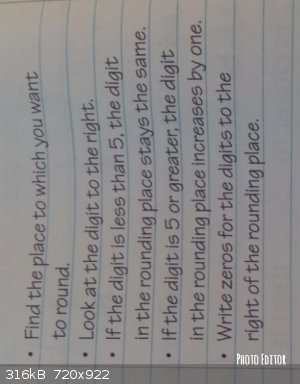fusso
International Hazard
    
Posts: 1922
Registered: 23-6-2017
Location: 4 ∥ universes ahead of you
Member Is Offline
|
|
Do electronic balances round the mass off or down?
Assume I have 1.005g of anything on a 2 decimal place balance.
Will it round the mass off to 1.01g or round down to 1.00g?
|
|
|
12thealchemist
Hazard to Others
  
Posts: 181
Registered: 1-1-2014
Location: The Isle of Albion
Member Is Offline
Mood: Rare and Earthy
|
|
When a balance has flickered between one weight and another, I always take that to be halfway between the two. So, if I had 1.005 g of something on a
balance, it would flick between 1.00 g and 1.01 g.
|
|
|
fusso
International Hazard
    
Posts: 1922
Registered: 23-6-2017
Location: 4 ∥ universes ahead of you
Member Is Offline
|
|
Quote: Originally posted by 12thealchemist  | | When a balance has flickered between one weight and another, I always take that to be halfway between the two. So, if I had 1.005 g of something on a
balance, it would flick between 1.00 g and 1.01 g. |
What about 1.008g?
|
|
|
12thealchemist
Hazard to Others
  
Posts: 181
Registered: 1-1-2014
Location: The Isle of Albion
Member Is Offline
Mood: Rare and Earthy
|
|
That would display as 1.01 g, I would assume
|
|
|
Sulaiman
International Hazard
    
Posts: 3695
Registered: 8-2-2015
Location: 3rd rock from the sun
Member Is Offline
|
|
Usually the resolution of digital scales is better than their linearity, repeatability and accuracy,
so it does not matter if it rounds up or down or alternates between the two 
P.S. Digitally it is easiest to use the next least significant binary digit
so <0.5 would be rounded down and >=0.5 rounded up,
which is also how it is generally handled in mathematics
[Edited on 13-10-2018 by Sulaiman]
|
|
|
Heptylene
Hazard to Others
  
Posts: 319
Registered: 22-10-2016
Member Is Offline
Mood: No Mood
|
|
I agree with Sulaiman. Unless you have a good quality scale with calibration weights, the resolution is probably better than the actual precision of
the scale.
To illustrate this, just take 10 consecutive measurements of the same object on your scale: the measured weight will likely not be the same every
time.
And the scale will be inaccurate depending on where you are on the earth, which is why you need the calibration weights. The gravitational
acceleration varies depending on where you are on the earth by a fraction of a percent, so if you measure something at 100.000 g, the thing might
actually have a mass of 100.067 g or 99.978g. Think about it if you bought the scale from another continent.
The scale might also drift off over time or due to transport.
|
|
|
fusso
International Hazard
    
Posts: 1922
Registered: 23-6-2017
Location: 4 ∥ universes ahead of you
Member Is Offline
|
|
JJBoyd is spam, plz report it
|
|
|
wg48
National Hazard
   
Posts: 821
Registered: 21-11-2015
Member Is Offline
Mood: No Mood
|
|
Quote: Originally posted by Sulaiman  | Usually the resolution of digital scales is better than their linearity, repeatability and accuracy,
so it does not matter if it rounds up or down or alternates between the two 
P.S. Digitally it is easiest to use the next least significant binary digit
so <0.5 would be rounded down and >=0.5 rounded up,
which is also how it is generally handled in mathematics
[Edited on 13-10-2018 by Sulaiman] |
In the presence of measurement noise with a zero mean distribution you have to round that way or you will introduce a bias in your readings.
Borosilicate glass:
Good temperature resistance and good thermal shock resistance but finite.
For normal, standard service typically 200-230°C, for short-term (minutes) service max 400°C
Maximum thermal shock resistance is 160°C
|
|
|
AJKOER
Radically Dubious
    
Posts: 3026
Registered: 7-5-2011
Member Is Offline
Mood: No Mood
|
|
Quote: Originally posted by Sulaiman  |
........
so <0.5 would be rounded down and >=0.5 rounded up,
which is also how it is generally handled in mathematics
[Edited on 13-10-2018 by Sulaiman] |
Actually, I recently was surprised to learn that the above generally cited rounding randomization rule is not taught in all states in America (like in
Florida, an increasingly pro-business state).
My take on the rationale of such randomization rule is that if you adds a large number of rounded numbers together, where the digit subject to
rounding is an assumed random deviate of some distribution, the result should demonstrate, on repetition, minor deviation bias from an unrounded
number total or average. However, this logic is off if the data was transformed and one is working with numbers having a non-symmetric distribution
(for example, ratio statistics).
I somehow doubt an underlying mathematical rationalization and a more likely reason for a bias rounding rule is due to some presumed educational or
legal or financial benefit (like it is OK for a bank to round down on interest payment to customers, or credit card companies can round up interest
payments due, as long as there is a disclosure document).
I speculate that existing laws probably cite generally taught standards. So, by changing to a bias rounding rule in schools, such hypothetical suspect
practices may have a legal foundation.
So, do electronic balances round the mass up or down? Well, that may depend on your zip code.
[Edited on 31-10-2018 by AJKOER]

[Edited on 31-10-2018 by AJKOER]
|
|
|